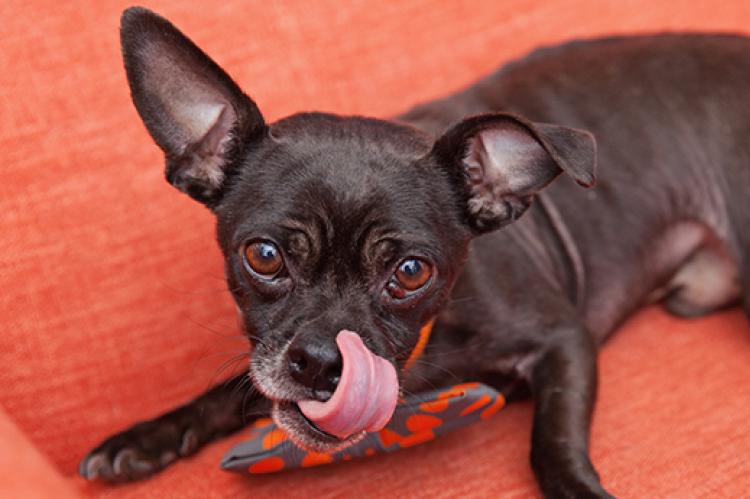Pica in Dogs: Causes, Diagnosis, Treatment

Pica in dogs is a disorder in which the dog ingests non-food items, such as rocks, dirt, or fabric, and it's a fairly common occurrence. Pica doesn't include the ingestion of trash or feces because the consumption of such things is often driven by different motivations. So how do you know if your dog has pica and how do you treat it? Learn about the common causes and remedies for pica in dogs.
What causes pica in dogs?
The causes of pica in dogs can be hard to determine, but they often include:
- Gastrointestinal disease
- Anemia
- Liver disease
- Pancreatic disease
- Diseases causing excess appetite, such as diabetes
- Neurologic diseases
- Poor diet
- Being on medications, such as prednisone
- Behavioral disorders, such as anxiety
- A stressful home environment
Ingesting non-food items can even be part of a dog's normal exploratory behavior (though not a part that should be encouraged).
When attempting to assess why your dog is engaging in this habit, consider the animal’s environment and lifestyle. Does your dog get enough exercise? Do they get an appropriate amount of attention? Are appropriate chew and play toys available? Is there competition for resources — that is, could the dog be eating inappropriate things to prevent another pet from getting to it first? Does the animal have a fairly consistent routine? Are there other things that could be causing stress for the animal?
How do I know if my dog has pica?
If you think your dog has pica, a thorough medical work-up is recommended. Along with a complete physical exam, this should include a fecal examination to check for gastrointestinal (GI) parasites and blood work to look for conditions such as anemia, liver disease, diabetes, and pancreatic disease.
Depending on the signs your dog is showing, more specific blood work — perhaps to see whether the GI tract is not absorbing nutrients — might be required. Typically, this involves checking folate and cobalamin levels and doing a TLI (trypsin-like immunoreactivity) test to check for pancreatic function. X-rays can also be warranted if there is concern about a GI obstruction and to rule out other potential causes of pica.
Of course, if abnormalities are noted, further testing might be needed. If an abnormality is found, the best course typically is to treat for that abnormality and see whether the pica improves.
Canine anxiety and pica
If medical reasons have been ruled out, then it’s worth consulting with a veterinary behaviorist, as behavioral issues such as anxiety often can lead to pica. If a behaviorist isn’t available in your area or within your budget, consulting with your veterinarian or a trainer can be helpful. Your veterinarian should be able to direct you to other professionals with expertise in dog behavior.
There are some basic things you can try without working with a behaviorist (though working with one does allow for the greatest chance of stopping the pica behavior):
- Make sure your dog is on a good-quality diet. Sometimes this change is all that’s needed.
- Along with diet, make sure the dog has plenty of exercise and mental stimulation. Go for walks, give your dog appropriate toys to play with, and make sure they get plenty of human interaction.
- If possible, limit your dog's access to the inappropriate items they try to eat. For instance, if your dog eats rocks, then keep the dog out of rocky areas. If this is too difficult or restrictive, have more attractive options available for the dog — such as treats or a Kong — when you're in rocky areas. In extreme cases, a basket muzzle might be helpful, but make sure the muzzle doesn’t restrict the dog’s ability to breathe. Remember, too, that the dog shouldn't wear the muzzle for extended periods of time.
- Remove any obvious stressors. For example, if your pet gets nervous when you play loud music, turn down the volume or wear headphones. If your dog gets agitated when the neighbor mows their lawn, keep your dog inside or take them on an adventure away from the activity.
- Provide a regular schedule for your pet. Regular walks, feeding times, and play times let an animal know that these things are coming, which can decrease anxiety.
- Above all else, don’t punish your animal for eating inappropriate things. This is not an effective training method, and it can just increase anxiety.
When pica is believed to be associated with anxiety, there are some medications that can help. However, it is important to use medications only under the direction of a veterinarian — and to make sure you keep working on the behavior as well. For instance, a dog who is anxious because they get inadequate exercise won't get better only from using medication. Rather, the dog needs regular exercise and mental stimulation too.
Finally, don't give up on managing your dog's pica. Greatly minimizing or eliminating the behavior is possible in many cases. And if it’s not managed, it can lead to destruction of belongings, dental problems for your pet, or, worst of all, emergency medical problems if the consumed object causes an obstruction or is toxic to your pet. Continue to share information with your vet so that together you can adjust your treatment plan as necessary.